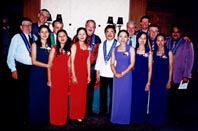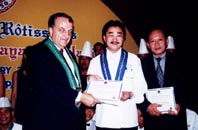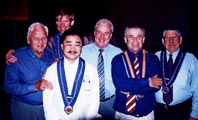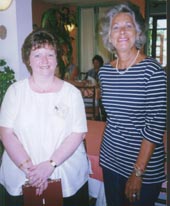
















|
China’s Long, Stone Serpent The Great Wall (Part 4)
by Chalerm Raksanti
The last leg of the Journey
 China’s stone serpen China’s stone serpen
From Hohhot, the capital city of Inner Mongolia, the train moves on to Yinchuan. Yinchuan is the capital of Ningxia Hui Autonomous Region, the centre of
Chinese Islam. One third of its inhabitants are Muslims, whom other Chinese call Hui, and consider a separate ethnic group. During the Cultural Revolution, the practice of
various religions was forbidden. The mosques remained empty of devotees and the imams and their daily call to prayers were silenced. Some mosques were vandalised and many
were totally destroyed. Today a more tolerant official view of religion has allowed the Hui to practice their faith unmolested. Still, the inescapable loudspeakers make their
presence known. They are the alarm clocks of rural China. The cacophony is an ear-splitting mixture of China’s morning news, martial music, public service messages, crop
and livestock prices, weather reports and a form of local advertising. The chaos results from the fact that the broadcasts are all coming from different speakers, set in
different directions, and it’s all going on at the same time. The only solution is to wrap a pillow around your ears and inwardly rage at the sheer intrusion of it all. The
practical reason for the loudspeakers is that not everyone can afford their own radio in the outlands.
 14th Century watchtowers at Jiayuguan Pass 14th Century watchtowers at Jiayuguan Pass
Here at Yinchuan, the Great Wall completes its crossing of the rolling steppes of the Ordos Plains, and eventually meets the Yellow River. On the east bank
the Wall is greatly diminished from erosion and neglect. Much of it at this location is barely twice the height of an average man. Nevertheless, there are few other places
where the Wall actually still serves a useful purpose. An irrigation canal has been dug along the top and water, which is drawn from the river on to this high ground, flows
into the level lands of the surrounding area and provides water for the wheat fields.
 Mongolian herdsman Mongolian herdsman
The final surviving section of the Great Wall on the northern frontier runs 500 miles from Yinchuan to Jiayuguan in the western desert. Here the Wall
protected the Silk Road from bandits and from drifting sands. It is paralleled for much of the way by the Xinjiang railway line. The Yinchuan-Jiayuguan journey takes about 28
hours. Sadly, in most places, only the barest outlines of the Wall still remain today. Jiayuguan is a grim industrial frontier city. Its primary economy is driven by blast
furnaces at the iron and steel mill, supported by nearby iron deposits. Other factories also churn out cement, chemicals, machinery and electrical appliances.
 Peasants of the Ordos Plains Peasants of the Ordos Plains
The last gate in the Wall is at the Jiayuguan Pass. It stands isolated on a rise, just a remnant of its former Ming grandeur. The once brilliant reds,
greens and yellows are surrendering their colours to the brown, packed earth. The battlements of the gate still stand. A walk along them shows that the Wall veers off in a
straight line and then seems to diminish in outline with distance. Here one sees grazing camels, a skeletal countryside of abandoned walled towns, dunes, and shimmering
mirages. And beyond that is the vast and endless desert.
For the Chinese, this western frontier had always symbolised danger, decline, invasion and oblivion. During most of the Great Wall’s history, travellers
from across the desert entered the Chinese empire at Jiayuguan. During the Ming Dynasty, the three-story barracks pavilion must have seemed electrifying after months in the
sinister outlands. The inscription on the dedication stone outside the gate at Jiayuguan reads: “Looking westward we see the long, long road... Who is not afraid of the
vast desert?” In other words, the message is this: We are China. Who are you?
The Chaine des Rotisseurs first Gala Dinner for 2001
Chef Pascal’s tour de force!
The Chaine des Rotisseurs, the world-wide association of gastronomes, is well represented in Pattaya, with its leader (known as the Bailli) being Walter
Jack Heller. To promote the art of fine food and wines, the Chaine arranges for several gala dinners each year, and the first for 2001 was held at the Dusit Resort, with the
retiring executive chef Pascal Schnyder being delegated to produce a menu suitable for the event. This he did, presenting the members of the Chaine with a spectacular
gustatory evening.
Imagine an eight course dinner, preceded by salmon crepes cooked al fresco outside the dining hall. Imagine top class wines, which included a dessert wine
which, until recently, was reserved for royalty. Imagine yourself sitting with like minded folk who also enjoy the experience of the fine dining table. That was the year’s
first gala dinner.
The formal dining began with truffled quail egg, which was followed by a calf’s sweetbread and goose liver mousse enhanced with Morels tangerine scented
tea vinaigrette. A dish displaying very delicately balanced flavours.
 Gastronomes and gastronomettes? Gastronomes and gastronomettes?
The wine chosen to accompany the initial courses, and supplied by Chaine member Yves Delecour of the Nicolas B.C. company, was a Muscadet de Sevre et Maine
Reserve Gold Medal, 1999, which complemented the food perfectly.
The next course consisted of grilled scallops (sounds so much nicer in the original French name of Coquille St. Jacques) and hot tomato tartar in an Indian
basil cream soup. For me, this was a truly inspired creation, the smoothness of the Coquille St. Jacques contrasting with the taste and texture of the Indian basil cream
soup. It was followed by a pigeon and crepes mushrooms in a crispy puff pastry. The pigeon meat having its own very distinctive taste.
 Walter Jack Heller (right) presents Chef Pascal with a
Chaine certificate of thank you. Walter Jack Heller (right) presents Chef Pascal with a
Chaine certificate of thank you.
The next dish was another truly special one, featuring oven seared black cod, “wrapped” in sliced zucchini and carrot, surrounded by a Noilly Prat
cream sauce with just a hint of olive oil and herbs. I have neither seen nor tasted such a different way to present this type of fish.
After a mangosteen sherbet as a palate cleanser, we were then presented with whole roasted beef tenderloin in a red wine butter sauce. This was in many
ways a culinary tribute to the origins of the Chaine des Rotisseurs, a society formed by the skilled beef roasters of almost 800 years ago. The original Rotisseurs would have
been proud of Chef Pascal’s beef masterpiece! To accompany this dish a 1998 Chateau la Metairie Fronsac red wine was chosen, which also met with approval from the diners.
 These guys know how to put away a meal or two... These guys know how to put away a meal or two...
If that were not enough, a cheese plate and then a dessert were presented. The amazing Bulgarian “royal” wine, a Tokay Aszu, was sipped with the
dessert of chocolate mousse on a caramelised almond ice cream.
To say that Chef Pascal surpassed himself for the members of the Chaine des Rotisseurs that evening would be an understatement. It was dedication to the
art of the table, the like of which I have never experienced before. Bravo Chef Pascal, and thank you, Walter Jack Heller, Bailli of the local Chaine des Rotisseurs for the
invitation to experience such a feast.
Those who would like to know more about the Chaine des Rotisseurs can contact Walter Jack Heller on (038) 427 777 any weekday morning. If you are
interested in fine food and dining tradition, you owe it to yourself to give him a call. The next gala dinner will be held on the 6th of May.
Thai Garden Resort receives a facelift
Thai Garden Resort, the nice hotel on North Pattaya Road almost opposite City Hall and World Gems, the one with the famous Moon River Pub and Restaurant,
has recently undergone a facelift.
 General manager Rene Pisters relaxes in the newly
decorated lobby. General manager Rene Pisters relaxes in the newly
decorated lobby.
The nice atmosphere, the friendly service, the beautiful gardens, the apartments for long term residents, the excellent food - has made the Thai Garden
Resort one of the most preferred family hotels in Pattaya. As one of the guests was heard to say, “Arriving at the Thai Garden is like coming home.” Well, this could be
the nicest compliment a hotel could ever get.
Since the new general manager, Rene Pisters, a multi-lingual Dutch man, took over in September last year, the Thai Garden Resort went through immediate
changes. He quickly acted like one of those famous plastic surgeons and simply gave the Thai Garden Resort a much-needed facelift.
The facelift did not make the resort look 20 years younger, but much more mature and sophisticated.
 Thai Garden Resort staff waiting for guests Thai Garden Resort staff waiting for guests
Rene Pisters says, “I began by renovating the public areas, as this gives the first impression of the resort. My objective was to create a typical
Oriental atmosphere with influences from Thailand, Myanmar, and Bali. It had to be practical, economical, yet elegant and durable. With strong support from the owning
company, I was able to move fast. Although we stood in front of the high season, we were able to complete all renovations well in time before the Festive Season. Yet there is
much more to come.”
Looking at the gardens and the outdoor swimming pool, it gives one a feeling of ancient Thailand. Garden art, wooden pergolas, pillars decorated with
Burmese tiles, statues with water plays breathing an air of tranquility. The entire concept is a perfect background to decorate the permanent stage which is used for
performances and parties, but doubles as a sun-terrace during daytime.
 The guests always enjoy the beautiful set-up and very
tasty buffets. The guests always enjoy the beautiful set-up and very
tasty buffets.
Especially at night, with spotlights lighting up the decorations, gardens, trees and bushes, it gives the impression of a fairytale, and one is actually
waiting to see the elves coming forward and dance around the pool.
The lobby is now most elegantly decorated and therefore one of the main attractions of the hotel. People just love to sit around there in the comfortable
and beautiful new furniture, enjoying the sounds and sights of the fountain, reading newspapers or just relaxing.
Not only the hardware was changed. Mr. Pisters revamped the Thai Garden’s breakfast buffet and it is fast becoming a gathering place for clients from
outside who come to enjoy fresh breakfast products. The new furniture compliments the new style of the Thai Garden and creates perfect scenery for the many dinner buffets the
hotel is organizing. It’s hard to describe - one has to see it and taste it!
 One of the romantic corners in the gardens of the Thai
Garden Resort. One of the romantic corners in the gardens of the Thai
Garden Resort.
The Paradise Pool and Gardens now has instant service available, whereby the guest can indicate to the service staff through wireless pushbuttons on the
umbrella stands that he wants to order a drink or meal. Service is what matters at this place.
The Moon River Pub, the musical “baby” of the Thai Garden Resort, is targeted to be the next to face a “facelift”. The management switched the
musical entertainment to hot-blooded Filipinos. The newly arrived O’ Zone band, a multi talented show band, which makes the audience go wild wherever they play, is
certainly a welcome addition to Pattaya’s night scene.
All in all, the Thai Garden Resort is more alive than ever, and Pattaya will hear a lot more about it!
Great turn out by Pattaya ladies at Pan Pan
The PILC ladies met at Pan Pan Restaurant last week for their monthly coffee morning. There was a record turn out, nearly standing room only, possibly
because of the delicious chocolates.
 PILC president Julie Garratt and Jan Howard at the Pan Pan
coffee morning PILC president Julie Garratt and Jan Howard at the Pan Pan
coffee morning
PILC’s president, the vivacious Julie Garrett said, “Just having the coffee mornings on a regular basis (on the third Tuesday of every month) is an
excellent way to meet and welcome new members to the club. I am really excited about our upcoming March lunch. We have a fabulous guest speaker, silk artist Lea
Dingjan-Laaraker, who will be talking at the Royal Cliff lunch. Lea is a very talented silk painting artist who has devoted the last four years to a community project at Ban
Ren Khai. She has been teaching the local ladies the techniques of dyeing and hand painting silk.
 PILC ladies Gail Bath with Pat Dixon at the Pan Pan
Restaurant PILC ladies Gail Bath with Pat Dixon at the Pan Pan
Restaurant
I think I will be putting a dent in my plastic, as there will be heaps of silk art works and dyed and hand painted fabrics for sale.
It is for a good cause, too, as all the proceeds will go back to the weaving project study foundation to develop a cottage industry. Everybody is
welcome.”
PILC March lunch, Tuesday March 6, 10:30 a.m. to 2 p.m. at the Royal Cliff, Siam Ballroom. Members 400 baht, guests 450 baht. For reservations email
[email protected] or telephone Angela 038- 225679.
District governors honour Jomtien-Pattaya Rotary Club meeting
The weekly meeting of the Jomtien-Pattaya Rotary Club last week was a special event for two reasons. The first was the attendance of the governor of R.I.
District 3340, Prempreecha Dibbayawan, and the second was the attendance of the governor of R.I. District 3350, Chow Nararidh, who was the keynote speaker for the evening.
The attraction of having the two governors at the meeting was such that the attendance was greater than the usual “Rotary Room” in the Royal Cliff
Grand could accommodate, and the Royal Cliff Beach Resort reserved the Rossini Restaurant for the Rotarians for the evening.
 Governor of R.I. District 3350, Chow Nararidh (right)
inducts Matti Kaikkonen and his wife. Governor of R.I. District 3350, Chow Nararidh (right)
inducts Matti Kaikkonen and his wife.
Governor Chow spoke of the involvement of District 3350 and the decision to bring the Bangkok based Rotarians to Pattaya for their district conference, and
said how much he was looking forward to the event.
Governor Prempreecha responded as the host district and spoke on the concept of the “Rotary Week” to be held in Pattaya, to coincide with the two
districts’ conferences - 3340 March 16-18 and 3350 March 23-25. You can expect to see many Rotary wheels in Pattaya during that time.
The running of the meeting was also assisted, or even well oiled, by the provision of complimentary wine supplied by Past President Peter Malhotra, whose
birthday, and that of President Elect Alvi Sinthuvanic, was celebrated by their fellow Rotarians.
British Chamber cautiously optimistic
 Enjoying the networking and a refreshment is P.R.
Dhamodhran, area manager for TRW Automotive, Kevin Burrell, business development manger for TNT, Albert-Jan Ars, logistic manager - warehousing for Katoen Natie Sembcorp
(Thailand) and Olaf Schaefer, branch manager of Schenker at Laem Chabang. Enjoying the networking and a refreshment is P.R.
Dhamodhran, area manager for TRW Automotive, Kevin Burrell, business development manger for TNT, Albert-Jan Ars, logistic manager - warehousing for Katoen Natie Sembcorp
(Thailand) and Olaf Schaefer, branch manager of Schenker at Laem Chabang.
The British Chamber of Commerce in Thailand held its monthly networking evening at Shenanigans last weekend. Executive director Greg Watkins was very
pleased with the turnout for the event and said that the Chamber is enjoying a resurgence in popularity, now having more members then at any time in its history.
 A few words by TNT Country Manager for Thailand Winfried
Kiebueye, sponsor of the evening. A few words by TNT Country Manager for Thailand Winfried
Kiebueye, sponsor of the evening.
Local representative on the Eastern Seaboard, Graham Macdonald, said the mood of the chamber was one of cautious optimism, following the recent elections
in Thailand. He felt that British investment would continue in this country and he predicted further higher levels during this year. With the current expansion going on in
the Eastern Seaboard, throughout many of the industrial estates, this was again a very positive sign for this region.
Sponsors of the evening were TNT Logistics, and their country general manager Winfried Kiesbueye said in a short address that his company was very pleased
to be part of the expanding trade in Thailand.
Antiques, Are They Genuine?
by Apichart Panyadee
Decorative Alterations
Carving
Nineteenth-century enthusiasm for Tudor, Elizabethan, and generally “Gothic” furniture did not stop at re-using old carved parts in new settings.
Carving was a minor rage. Not just for humble artisans, but also as a pastime for the gentry. During the 1850’s, Warwick became a centre for carving of the most elaborate
kind. The ornamentation ranged from fruit and clusters of flowers through to warriors in Tarzan-like fur drapes, brandishing anything from a trident to a club. Hunting
trophies, hunting scenes, and musical instruments were very popular with carvers. Naturally, this very popularity meant that the style was copied elsewhere. The finest
examples are still referred to as being of the Warwick School.
 Oak sideboard typical of the Warwick School Oak sideboard typical of the Warwick School
However, to gain practise, many untalented amateurs were set loose upon many a plain piece of 16 th or early 17th Century panelled or boarded blanket chest of that period. These pieces should be viewed with caution when they are elaborately carved. The
finest pieces would have received lavish attention, but the modest domestic pieces were not finely carved.
The re-assembly and re-carving of oak furniture from the 16 th and 17th Centuries was done largely during the 1850’s and 60’s, and was done for perfectly innocent reasons. This does not make any difference to commercial values
today. The article is not genuine. It did not start out its life that way. However, this kind of alteration was not done solely to increase its value.
 Back of a George II period dining chair with high relief
carving Back of a George II period dining chair with high relief
carving
Eighteenth-century furniture was rarely attacked by amateur carving classes following the Warwick School. It was done in furniture workshops. Good mid-18th Century mahogany furniture in the curvilinear style, elegant, and full of shape, but perfectly plain, went in one end of the workshop to
come out as the most elaborate Rococo and Baroque designers, such as William Kent, Thomas, Batty Langley, and Thomas Chippendale.
So how do you tell? The one guiding rule is, when a piece of furniture was to be carved, the maker allowed sufficient timber for the carver to create his
designs in high relief. When the job was finished, the carving appeared encrusted, as if the scrolls, shells, or whatever motifs had been applied. When the piece of furniture
was to be plain, no such extra timber was allowed. Any carving which was added afterward would have to be incised below the outline of the existing surface. This flat carving
is easily spotted.
Later veneering
The most common example of later veneering is when a piece of 18 th Century oak furniture, a chest of drawers,
for example, is taken to the workshop and surfaced with walnut veneer. It appears to be genuine because the rest of the tests pass. But pull out a drawer. And make sure the
components match the workmanship. Eighteenth and early 19th Century veneers were all cut by hand. It is not possible to hand cut a
veneer thinner than 1/16 inch. Machines can cut it paper thin. Also, a veneer “bubble”, more common on highly figured timbers, can be a guide. If the raised area is thin
enough to be depressed easily, the veneer is machine cut or the surface has been sanded down to remove damage.
Copyright 2001 Pattaya Mail Publishing Co.Ltd.
370/7-8 Pattaya Second Road, Pattaya City, Chonburi 20260, Thailand
Tel.66-38 411 240-1, 413 240-1, Fax:66-38 427 596; e-mail: [email protected]
|

Skal
International
|
 China’s stone serpen
China’s stone serpen 14th Century watchtowers at Jiayuguan Pass
14th Century watchtowers at Jiayuguan Pass Mongolian herdsman
Mongolian herdsman Peasants of the Ordos Plains
Peasants of the Ordos Plains Gastronomes and gastronomettes?
Gastronomes and gastronomettes? Walter Jack Heller (right) presents Chef Pascal with a
Chaine certificate of thank you.
Walter Jack Heller (right) presents Chef Pascal with a
Chaine certificate of thank you. These guys know how to put away a meal or two...
These guys know how to put away a meal or two... General manager Rene Pisters relaxes in the newly
decorated lobby.
General manager Rene Pisters relaxes in the newly
decorated lobby. Thai Garden Resort staff waiting for guests
Thai Garden Resort staff waiting for guests The guests always enjoy the beautiful set-up and very
tasty buffets.
The guests always enjoy the beautiful set-up and very
tasty buffets. One of the romantic corners in the gardens of the Thai
Garden Resort.
One of the romantic corners in the gardens of the Thai
Garden Resort. PILC president Julie Garratt and Jan Howard at the Pan Pan
coffee morning
PILC president Julie Garratt and Jan Howard at the Pan Pan
coffee morning PILC ladies Gail Bath with Pat Dixon at the Pan Pan
Restaurant
PILC ladies Gail Bath with Pat Dixon at the Pan Pan
Restaurant Governor of R.I. District 3350, Chow Nararidh (right)
inducts Matti Kaikkonen and his wife.
Governor of R.I. District 3350, Chow Nararidh (right)
inducts Matti Kaikkonen and his wife. Enjoying the networking and a refreshment is P.R.
Dhamodhran, area manager for TRW Automotive, Kevin Burrell, business development manger for TNT, Albert-Jan Ars, logistic manager - warehousing for Katoen Natie Sembcorp
(Thailand) and Olaf Schaefer, branch manager of Schenker at Laem Chabang.
Enjoying the networking and a refreshment is P.R.
Dhamodhran, area manager for TRW Automotive, Kevin Burrell, business development manger for TNT, Albert-Jan Ars, logistic manager - warehousing for Katoen Natie Sembcorp
(Thailand) and Olaf Schaefer, branch manager of Schenker at Laem Chabang. A few words by TNT Country Manager for Thailand Winfried
Kiebueye, sponsor of the evening.
A few words by TNT Country Manager for Thailand Winfried
Kiebueye, sponsor of the evening. Oak sideboard typical of the Warwick School
Oak sideboard typical of the Warwick School Back of a George II period dining chair with high relief
carving
Back of a George II period dining chair with high relief
carving